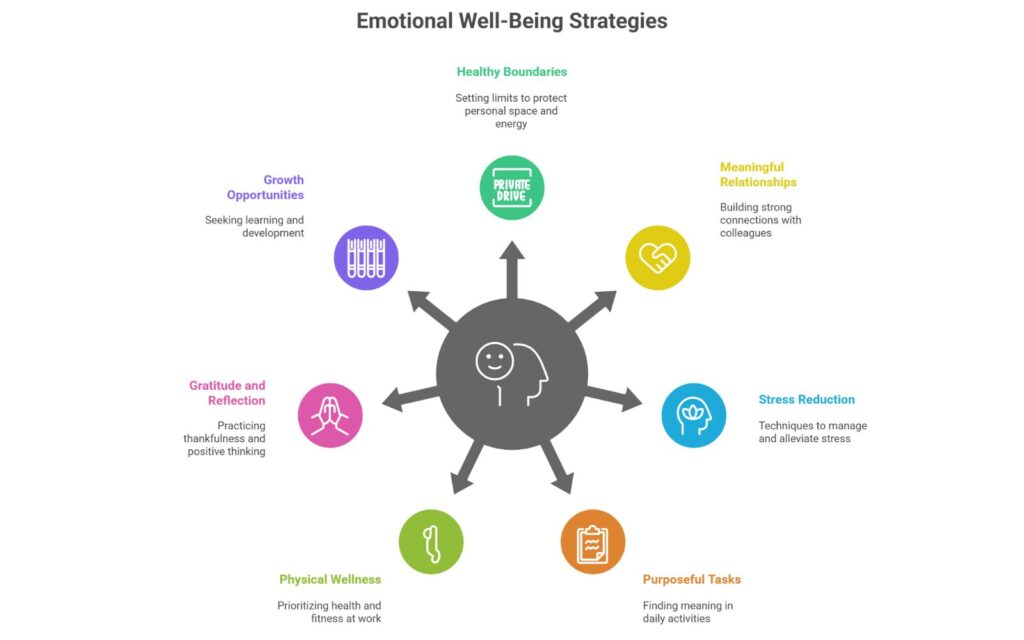How to Boost Emotional Well-Being at Work: 7 Science-Backed Strategies for a Healthier, More Sustainable Career

Did you know that 76% of employees report experiencing workplace burnout, with poor emotional well-being costing companies over $125 billion annually in healthcare costs? The modern workplace can feel like an emotional pressure cooker, leaving many professionals struggling to maintain their mental health while pursuing career success.
Learning how to boost emotional well-being at work isn’t just about feeling better-it’s about creating a sustainable, fulfilling career that aligns with your values and supports your overall life balance. Whether you’re navigating a demanding corporate environment or building an eco-conscious career, prioritizing your emotional health is essential for long-term success.
As someone who has coached hundreds of professionals through workplace stress and burnout, I’ve witnessed firsthand how small, intentional changes can transform not only your work experience but your entire approach to life-work integration.
Key Takeaway: Boosting emotional well-being at work requires a holistic approach that combines stress management, boundary setting, meaningful connections, and sustainable work practices that honor both your professional goals and personal values.
Understanding Workplace Emotional Well-Being

Emotional well-being at work encompasses your ability to manage stress, maintain positive relationships, find meaning in your tasks, and sustain energy throughout your career. It’s the foundation that determines whether you thrive or merely survive in your professional environment.
Unlike traditional work-life balance approaches, emotional well-being focuses on creating harmony between your inner emotional landscape and external work demands. This approach recognizes that sustainable success requires nurturing your mental health alongside your professional development.
Research from the Harvard Business Review shows that employees with high emotional well-being are 31% more productive, have 37% better sales performance, and are three times more likely to be creative problem-solvers.
The Connection Between Workplace Culture and Personal Values

Aligning Your Work with Your Values
One of the most powerful ways to boost emotional well-being at work is ensuring your role aligns with your core values. When your daily tasks conflict with what matters most to you, emotional exhaustion becomes inevitable.
Consider conducting a values audit: identify your top five personal values and evaluate how well your current role supports them. If you value environmental sustainability, seek opportunities to integrate eco-friendly practices into your work or transition toward companies with strong environmental missions.
Creating Micro-Environments of Well-Being
Even in challenging workplace cultures, you can create small pockets of emotional wellness. This might involve personalizing your workspace with plants, establishing walking meetings, or forming connections with like-minded colleagues who share your commitment to well-being and sustainability.
7 Practical Strategies to Enhance Your Emotional Well-Being

Strategy 1: Establish Healthy Boundaries
Setting clear boundaries is crucial for maintaining emotional balance. This includes learning to say no to excessive demands, protecting your personal time, and communicating your limits respectfully but firmly.
Start by identifying your non-negotiables-perhaps it’s leaving work by 6 PM to spend time in nature, or dedicating lunch breaks to mindfulness practices. Communicate these boundaries early and consistently maintain them.
Strategy 2: Cultivate Meaningful Work Relationships
Strong workplace relationships act as emotional buffers against stress and burnout. Invest time in building genuine connections with colleagues, mentors, and team members.
Practice active listening, offer support during challenging times, and celebrate others’ successes. These relationships create a support network that enhances resilience and job satisfaction.
Strategy 3: Implement Stress-Reduction Techniques
Develop a toolkit of stress-management strategies you can use throughout your workday. This might include deep breathing exercises, brief meditation sessions, or stepping outside for fresh air.
The key is consistency—practice these techniques regularly, not just during crisis moments. Even five minutes of mindful breathing can significantly impact your emotional state and decision-making capacity.
Strategy 4: Find Purpose in Your Daily Tasks
Connect your work to a larger purpose that resonates with your values. If you work in finance, perhaps you’re helping families achieve security. If you’re in marketing, maybe you’re connecting people with products that improve their lives.
When tasks feel mundane, remind yourself of the broader impact and how your contribution matters to the bigger picture.
Strategy 5: Prioritize Physical Wellness at Work
Your physical and emotional well-being are interconnected. Incorporate movement into your workday, choose nutritious meals, and stay hydrated.
Consider walking meetings, standing desk options, or brief stretching sessions between tasks. These physical practices directly support your emotional resilience and mental clarity.
Strategy 6: Practice Gratitude and Positive Reflection
Regularly acknowledge positive experiences and accomplishments at work. Keep a gratitude journal focused on workplace moments—successful collaborations, learning opportunities, or support from colleagues.
This practice rewires your brain to notice positive aspects of your work environment, naturally boosting your emotional well-being over time.
Strategy 7: Seek Growth and Learning Opportunities
Continuous learning and skill development contribute significantly to emotional well-being by providing a sense of progress and achievement. Identify areas for growth that align with your interests and career goals.
This might involve taking courses in sustainable business practices, developing leadership skills, or exploring new technologies that support more efficient, balanced work approaches.
Creating Sustainable Work Practices
Sustainability in your career means developing practices you can maintain long-term without compromising your health or values. This involves regular self-assessment, adjusting your approach as circumstances change, and recognizing when significant changes might be necessary.
Consider implementing weekly check-ins with yourself to assess your emotional well-being, stress levels, and overall job satisfaction. This proactive approach helps you address issues before they become overwhelming.
Practical Takeaways
- Start small: Choose one or two strategies to implement consistently rather than attempting dramatic changes all at once
- Create accountability: Share your well-being goals with a trusted colleague or mentor who can provide support and encouragement
- Schedule well-being activities: Treat emotional wellness practices as important appointments that deserve protection in your calendar
- Measure progress: Track your emotional well-being through regular self-reflection, noting improvements in stress levels, job satisfaction, and overall happiness
- Adapt as needed: Be flexible with your approach, adjusting strategies based on what works best for your unique situation and work environment
Summary
Learning how to boost emotional well-being at work is an ongoing journey that requires intentional effort and self-compassion. By implementing these evidence-based strategies-from setting healthy boundaries to cultivating meaningful relationships-you can create a more fulfilling, sustainable career experience.
Remember that emotional well-being isn’t a destination but a practice. Small, consistent actions compound over time, leading to significant improvements in both your professional satisfaction and overall quality of life. Your well-being matters not just for your own happiness, but for your ability to contribute meaningfully to your workplace and community.
Start with one strategy that resonates most with you, and gradually build your emotional wellness toolkit. What step will you take today to prioritize your emotional well-being at work?
FAQs About How to Boost Emotional Well-Being at Work
How long does it take to see improvements in emotional well-being at work?
Most people begin noticing positive changes within 2-4 weeks of consistently implementing well-being strategies. However, significant improvements in emotional resilience and job satisfaction typically develop over 2-3 months of sustained practice.
The key is maintaining consistency with small, daily actions rather than expecting immediate dramatic changes.
Can I boost emotional well-being at work even in a toxic workplace environment?
While challenging workplace cultures make it more difficult, you can still improve your emotional well-being through personal strategies like boundary setting, stress management techniques, and building supportive relationships outside your immediate work environment.
However, if toxicity severely impacts your mental health, consider seeking professional support or exploring alternative employment options.
What’s the difference between emotional well-being at work and work-life balance?
Emotional well-being at work focuses on your internal emotional state and how you respond to workplace challenges, while work-life balance typically addresses time management and separation between work and personal life.
Emotional well-being is more about creating sustainable practices that support your mental health regardless of your work schedule or environment.
How can I boost emotional well-being at work without affecting my productivity?
Many well-being strategies actually enhance productivity by improving focus, reducing stress-related mistakes, and increasing creative problem-solving abilities.
Start with brief practices like 5-minute breathing exercises or walking meetings that can be easily integrated into your existing schedule without reducing work output.
Should I discuss emotional well-being initiatives with my manager or HR department?
This depends on your workplace culture and relationships. If your organization values employee wellness, discussing your initiatives can lead to additional support and resources.
However, focus on framing these practices in terms of productivity and performance benefits rather than personal struggles, which helps maintain professional boundaries while advocating for your needs.





